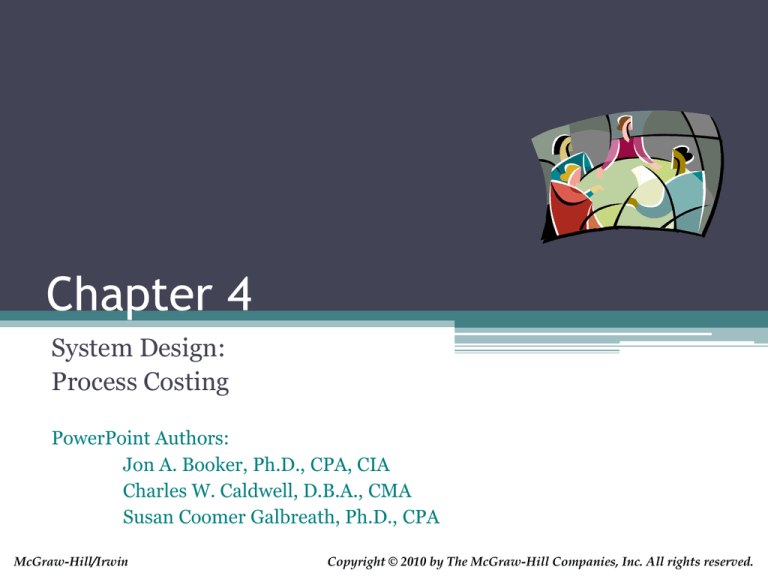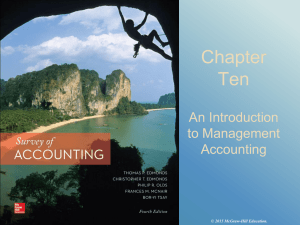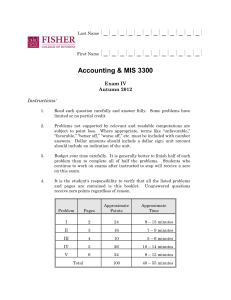
Chapter 4
System Design:
Process Costing
PowerPoint Authors:
Jon A. Booker, Ph.D., CPA, CIA
Charles W. Caldwell, D.B.A., CMA
Susan Coomer Galbreath, Ph.D., CPA
McGraw-Hill/Irwin
Copyright © 2010 by The McGraw-Hill Companies, Inc. All rights reserved.
4-2
Processing Departments
Any location in an organization where materials,
labor, or overhead are added to the product.
The activities performed in a processing
department are performed uniformly on all
units of production. Furthermore, the output
of a processing department must be
homogeneous.
4-3
Flow of Materials, Labor, and
Overhead Costs
Direct
Materials
Direct Labor
Manufacturing
Overhead
Costs are traced and
applied to departments
in a process cost
system.
Processing
Department
Finished
Goods
Cost of
Goods
Sold
4-4
The Flow of Raw Materials
(in T-Account form)
Raw Materials
•Direct
Materials
Work in Process
Department A
•Direct
Materials
Work in Process
Department B
•Direct
Materials
4-5
The Flow of Labor Costs
(in T-Account form)
Salaries and
Wages Payable
•Direct
Labor
Work in Process
Department A
•Direct
Materials
•Direct
Labor
Work in Process
Department B
•Direct
Materials
•Direct
Labor
4-6
The Flow of Manufacturing Overhead Costs
(in T-Account form)
Work in Process
Department A
Manufacturing
Overhead
•Actual
Overhead
•Overhead
Applied to
Work in
Process
•Direct
Materials
•Direct
Labor
•Applied
Overhead
Work in Process
Department B
•Direct
Materials
•Direct
Labor
•Applied
Overhead
4-7
Partially Completed Units Transferred
(in T-Account form)
Work in Process
Department A
•Direct
Materials
•Direct
Labor
•Applied
Overhead
Transferred
to Dept. B
Work in Process
Department B
•Direct
Materials
•Direct
Labor
•Applied
Overhead
•Transferred
from Dept. A
4-8
Transfer of Cost of Completed Units
(in T-Account form)
Work in Process
Department B
•Direct
•Cost of
Materials
Goods
•Direct
Manufactured
Labor
•Applied
Overhead
•Transferred
from Dept. A
Finished Goods
•Cost of
Goods
Manufactured
4-9
Cost of Finished Goods Sold
(in T-Account form)
Work in Process
Department B
Finished Goods
•Direct
•Cost of
•Cost of
•Cost of
Materials
Goods
Goods
Goods
•Direct
Manufactured
Manufactured
Sold
Labor
•Applied
Overhead
•Transferred
from Dept. A
Cost of Goods Sold
•Cost of
Goods
Sold
4-10
Equivalent Units of Production
Equivalent units are the product of the number
of partially completed units and the percentage
of completion of those units.
We need to calculate equivalent units because a
department usually has some partially completed
units in its beginning and ending inventory.
4-11
Equivalent Units – The Basic Idea
Two half completed products are
equivalent to one completed product.
+
=
1
So, 10,000 units 70% complete
are equivalent to 7,000 complete units.
4-12
Characteristics of the Weighted
Average Method
The weighted-average method . . .
• Makes no distinction between work done in
prior or current periods.
• Blends together units and costs from prior
and current periods.
The equivalent units of production for a
department are the number of units transferred
to the next department (or Finished Goods) plus
the equivalent units in the department’s ending
Work in Process inventory.
4-13
Treatment of Direct Labor
Dollar Amount
Direct
Materials
Direct labor costs
may be small
Conversion
in comparison to
other product
costs in process
costing systems.
Type of Product Cost
Direct labor and manufacturing overhead may be
combined into one product cost called conversion.
4-14
Compute and Apply Costs
The formula for computing the cost per
equivalent unit is:
Cost per
equivalent =
unit
Cost of beginning
Work in Process + Cost added during
inventory
the period
Equivalent units of production
Appendix 4A
FIFO Method
PowerPoint Authors:
Jon A. Booker, Ph.D., CPA, CIA
Charles W. Caldwell, D.B.A., CMA
Susan Coomer Galbreath, Ph.D., CPA
McGraw-Hill/Irwin
Copyright © 2010 by The McGraw-Hill Companies, Inc. All rights reserved.
4-16
FIFO vs. Weighted-Average Method
The FIFO method (generally considered
more accurate that the weighted-average
method) differs from the weighted-average
method in two ways:
1. The computation of equivalent units.
2. The way in which the costs of beginning
inventory are treated.
4-17
Cost per Equivalent Unit - FIFO
The formula for computing the cost per
equivalent unit under FIFO method is:
Cost per
equivalent =
unit
Cost added during the period
Equivalent units of production
4-18
A Comparison of Costing Methods
In a lean production environment, FIFO and
weighted-average methods yield similar
unit costs.
When considering cost control, FIFO is
superior to weighted-average because it
does not mix costs of the current period with
costs of the prior period.
4-19
End of Chapter 4






